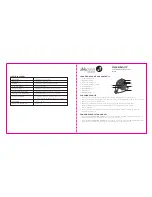
Guardian Telecom
VoIP Telephones
Setup & Configuration
Page 21
Backup SIP Auth Password 2:
Specify the Authenticate Password for the second backup SIP
server. This parameter is required for SIP registration
authentication. Enter up to 64 alphanumeric characters.
Remote SIP Port:
The Remote SIP Port is the port number the device will use as the
destination port when sending SIP messages. The default Remote
SIP Port is 5060. The supported range is 0-65536. Enter up to 5
digits.
Local SIP Port:
The Local SIP Port is the port number the device will use to receive
SIP messages. The default Local SIP Port is 5060. The supported
range is 0- 65536. Enter up to 5 digits.
Outbound Proxy
Enter the Outbound Proxy address as an IPv4 address in dotted
decimal notation or a fully qualified domain name (FQDN). When an
IP address is configured, the device will send all SIP messages to
this IP address. When an FQDN is configured, the device will run
DNS NAPTR, SRV, and A queries on the FQDN to resolve an IP
address to which it will send all SIP messages. This field can accept
entries of up to 255 characters in length.
Outbound Proxy Port:
The Outbound Proxy Port is port number used as the destination
port when sending SIP messages to the outbound proxy. A value of
0 will default to 5060. The supported range is 0-65536. Enter up to
5 digits.
Disable report Discovery:
Disabling report Discovery will prevent the device from including the
public WAN IP address and port number in the contact information
that is sent to the remote SIP servers. This will generally only need
to be enabled when using an SBC or SIP ALG in conjunction with a
remote SIP server.
Re-registration Interval (in
seconds):
The SIP Re-registration interval (in seconds) is the SIP Registration
lease time, also known as the expiry. The supported range is 30-
3600 seconds. Enter up to 4 digits.
Unregister on Boot:
When enabled, the device will send one registration with an expiry
of 0 on boot.
Keep Alive Period:
The minimum time in milliseconds between keep-alive packets sent
for nat traversal. A value of 0 will disable keep alive packets.
Enable Nightringer:
When Nightringer is enabled, the device will attempt to register a
second extension with the SIP server. Any calls made to this
extension will play a ringtone (corresponds to
Night Ring
on the
Audiofiles
page). By design, it is not possible to answer a call to
the Nightringer extension.
Nightringer Settings
SIP Server:
Enter the SIP server address as an IPv4 address in dotted decimal
notation or a fully qualified domain name. This parameter also
becomes the host portion of the SIP-URI for the device's Nightringer
extension on the SIP server. This field can accept entries of up to
255 characters in length.
Remote SIP Port:
The Remote SIP Port is the port number the device will use as the
destination port when sending SIP messages for the Nightringer
extension. The default Remote SIP Port is 5060. The supported
range is 0-65536. Enter up to 5 digits.
Local SIP Port:
The Local SIP Port is the port number the device will use to receive
SIP messages for the Nightringer extension. This value cannot be
the same as the
Local SIP Port
for the primary extension. The
default Local SIP Port is 5061. The supported range is 0-65536.
Enter up to 5 digits.
Outbound Proxy:
Enter the Outbound Proxy address as an IPv4 address in dotted
decimal notation or a fully qualified domain name (FQDN). When an
IP address is configured, the device will send all SIP messages to
this IP address for the Nightringer extension. When an FQDN is
configured, the device will run DNS NAPTR, SRV, and A queries on
the FQDN to resolve an IP address to which it will send all SIP
messages for the Nightringer extension. This field can accept
entries of up to 255 characters in length.
















































